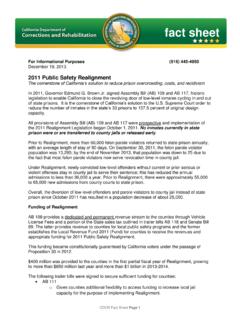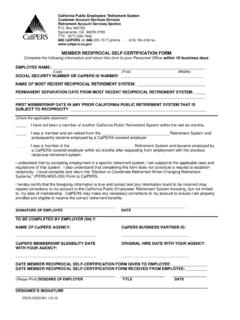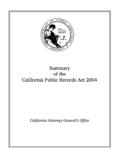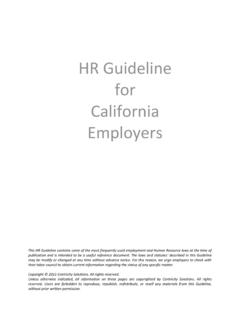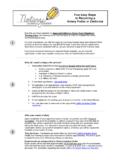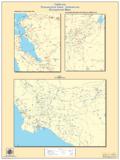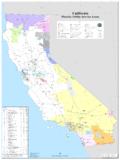Transcription of Visiting A Friend or Loved One in Prison - cdcr.ca.gov
1 Visiting A Friend or Loved One in Prison Introduction Visiting a family member or Friend who is in Prison is an important way to maintain connections during incarceration and enhances the prisoner's success both while in Prison and after release. The california Department of Corrections and Rehabilitation (CDCR) recognizes the importance of visitation and encourages families and friends to visit as often as their circumstances allow. Nevertheless, Visiting at a Prison can be complicated and confusing, especially when Visiting for the first time. This handbook is a useful guide for visitors, taking you through the process step-by-step, explaining the procedures and rules, and providing information and guidance on what you will need to do to visit and what you will encounter as you go through the process.
2 Preparing To Visit A. Application to Visit a Prisoner Any adult wishing to visit a prisoner must first obtain approval from CDCR. You must apply for approval to visit by completing a Visitor Questionnaire (CDCR Form 106). You obtain the Visitor Questionnaire by having the prisoner you wish to visit send it to you. The prisoner must sign the questionnaire before sending it to the prospective visitor; the signature confirms the prisoner's agreement to have the applicant added to his/her Visiting list. It is important to fill out the questionnaire completely. The questionnaire calls for the applicant to list all criminal convictions and all arrests, even if the arrest never led to charges or conviction. CDCR will conduct a background check for arrests and convictions when processing the application and will deny approval to visit if the check indicates an arrest or conviction not listed on the questionnaire, so you should be thorough when completing the questionnaire.
3 It is important to note that any contact with law enforcement may result in a record of the contact in the california Law Enforcement Telecommunication System, and may require clarification by the applicant. If you are unable to remember all the specifics about an arrest or conviction, be as specific as you can in providing the approximate date and the cause of the arrest. Mail the completed questionnaire to the Visiting Sergeant and/or Lieutenant where the prisoner you want to visit is housed. Mailing addresses are listed at the end of this handbook (see Attachment 1) and are also on CDCR's website Most prisons have different addresses for mail being sent to a prisoner and mail being sent to Prison staff; be sure to get the address used for sending mail to Prison staff, as the completed application should be sent to the attention of Visiting at the Prison .
4 Processing times for Visiting questionnaires vary by institution based upon the volume of forms received and the number of staff approved to perform the review process. Visiting A Friend or Loved One In Prison 1. If you are approved to visit, the prisoner is notified and he/she must notify you. Once approved, you are listed in the computer as being an approved visitor for the prisoner; you do not need to bring any proof of approval with you to the Prison . If you are disapproved, you will receive a letter from the Prison setting forth the reason for disapproval; the prisoner will also receive notice of the disapproval but will not be given the reason. If you are denied approval to visit, you may reapply, you may appeal the denial and/or the prisoner may appeal the denial.
5 If the reason for the denial is based on inaccurate or incomplete information on the Visitor Questionnaire, you may resubmit an accurate and complete questionnaire. Sometimes the reason for denial is that the Prison requires additional information (for example, evidence that the applicant is no longer on probation); in those cases, you should resubmit the questionnaire and provide the additional information. If you do not agree with the reason given for the disapproval, you may appeal by writing to the Warden at the Prison . He/she is required to respond to your appeal within 15 working days of receiving the appeal. If dissatisfied with the institution's response or action, you may refer your appeal, with a copy of the institution's decision, to the Director of the Division of Adult Institutions or his/her designee at: california Department of Corrections and Rehabilitation, Division of Adult Institutions, P.
6 O. Box 942883, Sacramento, california , 94283-0001, Attention: Director, Room 351-N. A written response to appeals addressed to the Director shall be provided within 20 working days from the date of receipt. The prisoner may independently appeal the denial of approval by utilizing the normal prisoner appeal process within the Prison . Sometimes emergency or hardship visits are allowed before a person has been approved to visit. Such visits are at the discretion of Prison staff (usually the Visiting Sergeant or Lieutenant) and are usually to accommodate an unexpected visitor traveling from a distance in excess of 250 miles. You should not rely on receiving approval to visit without going through the normal Visiting application process.
7 Whenever possible, you should plan ahead for visits and have each adult who might want to visit submit applications before they embark on a trip that will include a visit to a prisoner. B. Locating a Prisoner To find the location of the prisoner you wish to visit, you can visit the CDCR Website ( ) and click on Inmate Locator. If you do not have access to a computer, you can call the Identification Unit at (916) 445-6713, or fax that unit a request at (916) 322-0500. If you call the Identification Unit, you will need to provide the full name and date of birth of the prisoner you wish to locate or his/her CDCR. identification number. The Identification Unit will provide you with only the prisoner's current location and his identification number but is unable to provide you with any other information.
8 The Identification Unit is available only Monday through Friday (excluding holidays) from 8:00 to 5:00 It may take up to a week for housing information on a prisoner only recently admitted to CDCR or transferred between prisons to get in the computer system (and thus be available through the Identification Unit). Visiting A Friend or Loved One In Prison 2. C. Prisoner's Eligibility to Visit and Types of Visits All prisoners are eligible to receive visits unless they have temporarily lost that privilege due to disciplinary action. There are, however, different types of visits. Most prisoners are in the general population and may receive contact visits. Contact visits allow the prisoner to sit together with his/her visitors and have limited physical contact with them (a brief kiss and/or hug at beginning and end of visit, hold hands during the visit).
9 These visits occur in a large Visiting room, usually furnished with tables and chairs and usually shared with many other prisoners and visitors. Contact visits are restricted to five visitors at a time. Contact visits are not limited in duration except for normal Visiting hours or terminations caused by overcrowding to allow other visits to begin. Prisoners who are still in reception (recently admitted to CDCR or transferred between prisons) or who are segregated ( , Administrative Segregation, Security Housing Units, Adjustment Centers, pending specific rules violation report charges, or assigned to Behavior Management Units) are restricted to non-contact visits. Non-contact visits occur with a glass partition between the prisoner and his/her visitors.
10 The prisoner is escorted in handcuffs by staff to the visit. The handcuffs are removed only after the prisoner is secured in his/her side of the Visiting booth;. thus, parents who do not wish to have children see the prisoner in restraints should wait away from the booth or glass partition until the prisoner is settled. Non-contact visits are restricted to three visitors and are limited in time (usually one to two hours, depending on the Prison and the reason for the non-contact status of visits). Prisoners on Death Row, often referred to as condemned prisoners, are housed either at San Quentin State Prison in Marin County (men) or at Central california Women's Facility in Chowchilla (women). Condemned Grade A prisoners on Death Row may receive contact visits (meaning no partition between prisoner and his/her visitor) unless their Visiting privileges have been restricted for disciplinary or security reasons.




